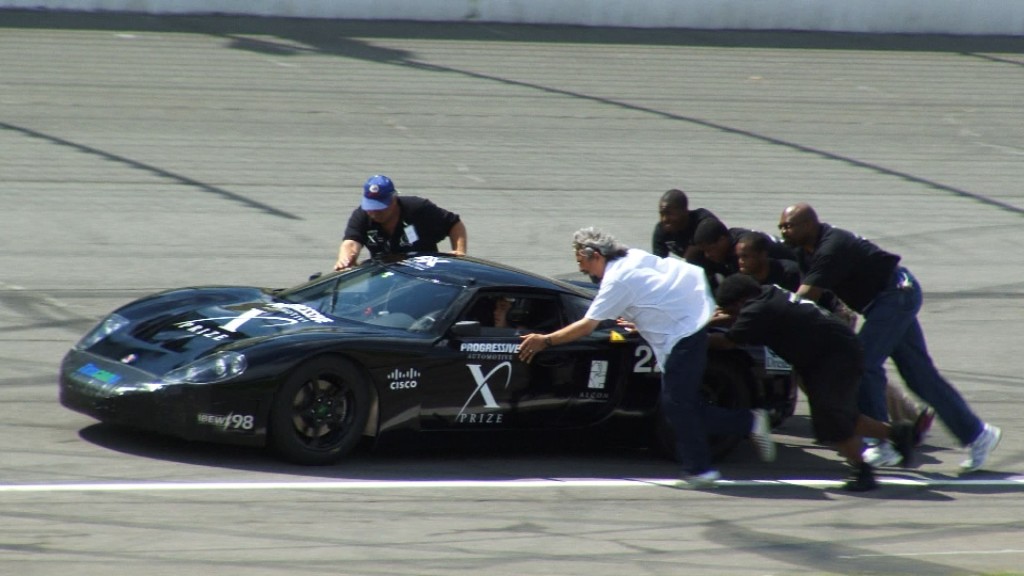The Automotive X Prize: A Primer

July 17, 2012
Share
When a group of teenagers from West Philadelphia High School showed up at the 2010 Progressive Automotive X Prize competition in Michigan, they were just a few of the innovators working toward a single goal: to construct a vehicle capable of getting 100 miles per gallon gasoline equivalent (MPGe) during normal driving.
The competition, announced in 2007 by the X Prize Foundation, challenged teams to build one of two types of cars:
- A mainstream class car that seats at least four passengers, has four wheels and has a minimum 200 mile range
- An alternative class car that seats at least two passengers with a minimum 100 mile range and no minimum on the number of wheels
The West Philly EVX team built one of each. Their team was one of 111 that made it past the first stage of competition; by the time they made it to the final rounds in 2010, fewer than 30 teams were left. Theirs was the only one based out of a high school.
In order to win, a vehicle had to meet the following requirements:
- Complete all on-track tests
- Demonstrate fuel economy numbers equal to at least 100 MPGe
- Pass all Federal Motor Vehicle Safety Standards and Regulations
- Complete validation testing on the chassis dynamometer (basically a powertrain measurement)
In the case of a tie, speed would be the deciding factor.
The EVX Team advanced to the knockout round, but failed to meet the 67 mpg requirement to move on to the finals. You can watch the results of their tests in real-time on the X Prize website.
After additional stages of competition, three teams came away with prizes: Oliver Kuttner’s Edison2 Very Light Car reached 102.5 mpg and won $5 million in the mainstream class, while Li-Ion Motors and Peraves X-Tracer Team Switzerland split the remaining $5 million for the alternative class division.
X Prizes, however, are not just limited to cars.
In 1996, Peter Diamandis founded the nonprofit X Prize Foundation to “bring about radical breakthroughs for the benefit of humanity.” Specifically, the foundation encourages groups to push the boundaries of engineering by setting up competitions to build next-level technology. The incentives are lucrative and can reach $10 million. (The foundation’s website has an entire section on breakthroughs throughout history that occurred as a result of the result of competition.)
There are four competition categories: education and global development; energy and environment (the Automotive X Prize falls under this); life sciences; and exploration (deep ocean and space).
Yes, space. The foundation is probably most well-known for the $10 million Ansari X Prize. Announced in 1996, it challenged innovators to build a spacecraft capable of carrying three people 100 kilometers above the earth’s surface, twice within two weeks. Twenty-six teams competed and, in 2004, the prize was awarded to a company called Scaled Composites. “Spaceflight was no longer the exclusive realm of government,” the foundation writes. “With that single flight, and the winning of the $10 million Ansari X PRIZE, a new industry was born.”
Other competitions involve sending a robot to the moon; developing a new way to quickly and easily clean up after oil spills; and sequencing “100 whole human genomes to a level of accuracy never before achieved.”
For more on Diamandis, his foundation and his goals for the future, read his recent interview with Wired.
Related Documentaries
Latest Documentaries
Related Stories
Related Stories
Policies
Teacher Center
Funding for FRONTLINE is provided through the support of PBS viewers and by the Corporation for Public Broadcasting. Additional funding is provided by the Abrams Foundation; Park Foundation; the John D. and Catherine T. MacArthur Foundation; and the FRONTLINE Journalism Fund with major support from Jon and Jo Ann Hagler on behalf of the Jon L. Hagler Foundation, and additional support from Koo and Patricia Yuen. FRONTLINE is a registered trademark of WGBH Educational Foundation. Web Site Copyright ©1995-2025 WGBH Educational Foundation. PBS is a 501(c)(3) not-for-profit organization.



















